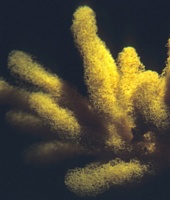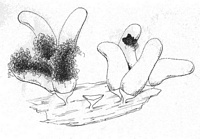|
 Arcyria obvelata Arcyria obvelata
SynonymsArcyria flava
Arcyria nutans
Embolus obvelatus
Trichia nutans
BiostatusPresent in region - Indigenous. Non endemic
Images (click to enlarge)
Owner: J.A. Cooper | 
Caption: Sporangia of Arcyria obvelata. Those on the left are beginning to expand. Each sporangium (before expansion) is about 2 mm tall.
Owner: S.L. Stephenson |
Article: Stephenson, S.L. (2003). Myxomycetes of New Zealand. Fungi of New Zealand. Ngā Harore o Aotearoa 3: xiv + 238 p. Hong Kong: Fungal Diversity Press.
Description: Fruiting body a stalked sporangium, crowded, initially 1.5–2.0 mm tall but expanding to 4–12 mm. Sporotheca cylindrical, bright to pale yellow, fading to pale ochraceous or beige (rarely with pale flesh-coloured tints), 0.3–0.5 mm in diameter. Stalk weak, slender, beige or yellow, usually very short. Hypothallus contiguous for a group of sporangia, colourless. Peridium persisting in mature fruiting bodies only as a distinct calyculus, the latter small, shallow, flaccid, translucent, spiny-reticulate on the inner surface. Capillitium strongly elastic, deciduous, flaccid and drooping, consisting of filaments 3–4 µm in diameter, sculptured with half-rings, spines, and fragmentary reticulations. Spores pale yellow in mass, nearly colourless by transmitted light, 6–8 µm in diameter, nearly smooth but with a few scattered warts. Plasmodium watery white.
Habitat: Decaying wood.
Distribution: Cosmopolitan (Martin & Alexopoulos 1969). First reported (as Arcyria flava) from New Zealand by Lister & Lister (1905), based on a specimen collected in Taranaki. Also known from Auckland, Bay of Plenty (Cheesman & Lister 1915), Dunedin, Southland, and Stewart Island.
Notes: The pale yellow colour and greatly expanding (to the point of becoming “fluffy” in mature specimens) capillitium make Arcyria obvelata an easy species to recognise in the field. This species is listed as A. nutans in most taxonomic treatments of the myxomycetes
|